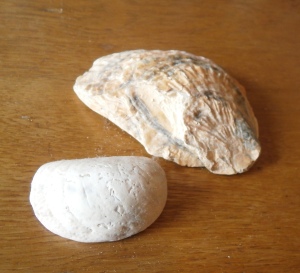Many shellfish live round our sandy East Anglian beaches; cockles and shrimps inhabit the Wash, whelks are caught off Wells-next-the-Sea and Cromer is namely for its crabs. A crab has a shell, so it must count as a shellfish; but most people think of little things like cockles, mussels and oysters when they refer to shellfish. If you include crabs and lobsters, then crabs are my favourite kind of shellfish – perhaps even my favourite of all fish. Lobsters do not appeal to me in the same way, in spite of making a much more gourmet dish. It is all part of being a Norfolk boy I suppose. We tend to save the crabs for ourselves and send the inferior lobsters off to the London market, where the poor suckers think they are delicious. As for shrimps and prawns, they are rather like little lobsters, only tastier, so they must be included too. I like shrimps almost as much as crabs, and was disappointed when my local supermarket stopped selling them in pots. I cannot buy crab paste either, although I can still get cockles and mussels there.
For many years I thought that I was allergic to mussels because I was ill after eating them – twice. Eventually I summoned up the courage and tried mussels again, with no ill effects. Either I was quite wrong about my allergy, or the passing years have toughened up my digestion. I can eat mussels now, but I was still shunning them when a few years ago I went with my wife Molly and our daughter to spend a week in Dieppe. There moules et frites were a very popular dish, and you saw people tucking into them at all the restaurants as we walked along the streets. I wish now that I had tried them.
There are shellfish that appear at both ends of the social scale, but I think my attitude must be middle class, and here’s why. Oysters come right at the top for elegant eating, even above lobsters. There is a common misconception that they used to be the food of the poor that was shunned by the rich. In the fishing ports they may have been eaten by the poor, but when they were carried miles inland by horse and cart they were an expensive luxury for the well-to-do. I have never tasted an oyster; I was put off by being told that they must be swallowed alive without being chewed. If that is really true it is for me both repulsive and pointless; eating a living creature is disgusting, and swallowing it without properly tasting it is foolish. I do acknowledge that those who do eat oyster find them exquisite, but I will never be of their number. They tend not to appear on the cockle stalls that still exist around our seaside towns, and I will stick with what is available there. Whelks still make part of the stock-in-trade of the cockle stall – perhaps I should call it a whelk stall – but these shellfish occupy the other end of the social scale, being without doubt a proletarian food. They are not as tasty as cockles and are rather tough. They do not come right at the bottom of the list as far as desirability goes, for that position is taken by winkles; these mini-whelks are in fact not as tough as their bigger cousins, although you have to pick the edible part from the shell with a pin. Whelks would also need pins, only they are usually removed from their shells before you buy them. Winkles are like the high class oyster in one respect though – I have never seen them for sale on a cockle stall. All these other shellfish are all cooked before you eat them. By the way, I quite like winkles.
Another rather high class variety of shellfish is the coquille St Jacques, better known in England as the scallop. The French term gives a hint of their appearance; they resemble giant cockles. They are quite tasty but when served on a half scallop shell I think the visual presentation is a large part of the attraction. Coquilles St Jacques are traditionally served with duchesse potatoes (it sounds more elegant than mash). The most exclusive shellfish I have eaten is the ormer. Unlike a lobster which is a crustacean, or a cockle which is a mollusc, an ormer is a gastropod like a whelk. This is a prized delicacy in the Channel Islands (about the northern limit of their distribution), where over-fishing has led to the strict control of ormering. Fifty years ago, when I was a frequent visitor to Guernsey to see my sister, there was no legal restriction on catching ormers and Tiggie would occasionally cook them for supper. There were a great treat even then, but a hundred years ago they were not the esteemed delicacy they are today. Then they were just the everyday food of humble Channel Islanders.
JOSEPH MASON

But I adore scampi – when they are accurately cooked – not roasted in breadcrumbs.
LikeLike
Scampi is not a kind of shellfish but a dish consisting of shrimps, prawns, Norwegian lobsters etc.
LikeLike